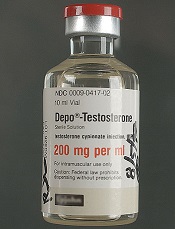
for intramuscular injection
Contrary to previous findings, a new study suggests there is no link between testosterone therapy and venous thromboembolism (VTE).
Investigators analyzed more than 30,000 commercially insured men who were age 40 and older, comparing men with VTE to those without the
condition.
Results indicated that exposure to testosterone therapy did not confer an increased risk of VTE.
The investigators reported these results in Mayo Clinic Proceedings.
“In 2014, the [US Food and Drug Administration] required manufacturers to add a warning about potential risks of VTE to the label of all approved testosterone products,” said Jacques Baillargeon, PhD, of the University of Texas Medical Branch at Galveston.
“The warning, however, is based primarily on post-marketing drug surveillance and case reports. To date, there have been no published, comparative, large-scale studies examining the association of testosterone therapy and the risk of VTE.”
With that in mind, Dr Baillargeon and his colleagues conducted a case-control study of 30,572 men age 40 and older. The men were enrolled in one of the nation’s largest commercial insurance programs between January 1, 2007 and December 31, 2012.
Cases were defined as men who had a primary diagnosis of VTE and received an anticoagulant or an intravascular vena cava filter in the 60 days following their diagnoses.
Each case was matched with 3 control subjects by age, geographic region, diagnosis of low testosterone, and diagnosis of any underlying coagulopathy.
The investigators found that being exposed to testosterone therapy in the previous 15 days was not associated with an increased risk of VTE. The adjusted odds ratio was 0.90 for 15 days, and findings were similar for exposure within 30 days and 60 days.
Dr Baillargeon and his colleagues also looked at specific routes of administration for testosterone therapy—topical creams, transdermal patches, and intramuscular injections.
The team found no increased risk of VTE with any of these methods. The adjusted odds ratios were 0.80 for topical, 0.91 for transdermal, and 1.15 for intramuscular administration.
“It is important to acknowledge, for a man who has medically diagnosed low testosterone, that there are clear risks to not receiving testosterone therapy, including osteoporosis, sexual dysfunction, increased amounts of fat tissue, decreased lean muscle mass, possible metabolic syndrome, and cardiovascular disease,” Dr Baillargeon said.
“It’s also important to note that further research needs to be conducted to rigorously assess the long-term risks of testosterone therapy. These findings may help to inform the benefit-risk assessment for men with testosterone deficiency considering treatment.”


